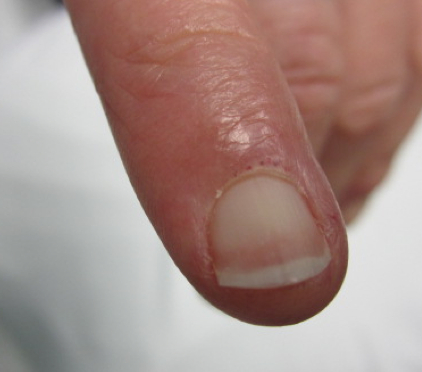History and exam
Key diagnostic factors
common
digit pain/discomfort
Common presenting symptom.
digital paresthesia
Paresthesias can occur when the fingers are rewarming. However, paresthesias are common and nonspecific, so RP would not be considered in a patient with hand paresthesias without a history of well-demarcated pallor of fingers.[4]
pallor of digits
This must be present to diagnose primary and secondary RP.[29]
red and/or blue discoloration of digits
At least one must be present to diagnose primary RP and secondary RP.[29]
dilated capillaries at nailbeds
Occurs mainly in secondary RP; if present, secondary RP should be assumed until proven otherwise. Dilated capillaries result from dropout of capillaries with secondary hyperplasia and hypertrophy of the remaining blood vessels. On inspection, these capillaries can appear like discrete red pen marks and are often seen around the cuticle.
[Figure caption and citation for the preceding image starts]: Visible dilated capillaries at the nailbedFrom the personal collection of Dr Janet Pope; used with permission [Citation ends].
well-defined discoloration
In all cases of RP there are well-defined areas of pallor, which then display cyanosis followed by rubor.[29]
magnification of nailbeds
Presence of dilated capillaries at the nailbeds that look like red pen marks are often seen at the cuticle. This finding is highly specific for secondary RP, although not sensitive. It helps to rule in secondary RP if positive.[30]
Other diagnostic factors
uncommon
heartburn
May indicate secondary RP.
dysphagia
May indicate secondary RP.
puffy hands
May indicate secondary RP.
tight skin
May indicate secondary RP.
arthralgia
May indicate secondary RP.
photosensitivity
May indicate secondary RP.
oral/nasal ulcers
May indicate secondary RP.
alopecia
May indicate secondary RP.
butterfly rash
May indicate secondary RP.
sclerodactyly
May rarely be a complication of longstanding and frequent RP but if not in a patient with connective tissue disease, the tightening of the skin is usually distal to proximal interphalangeal joints (i.e., not entire fingers).
telangiectasia
May indicate secondary RP.
pleuritic chest pain
May indicate secondary RP.
digital ulcers
A recognized complication of RP. The presence of digital ulceration is generally thought to exclude a diagnosis of primary RP, so a secondary cause should be sought if ulceration occurs.
digital pits
A recognized complication of RP.
digital tuft resorption
A recognized complication of RP.
gangrene of fingertip/finger
A recognized complication of RP.
raised painful red lesions on finger tips
Sometimes RP features are accompanied by chilblains (perniosis), but this is a separate condition with red raised areas on tips of toes or fingers in the cold, often like frostbite. They may heal with desquamation, may be painful, are often multiple, and may be cyclical.
autoamputation
A recognized complication of RP. Nearly only in secondary RP.
Risk factors
strong
female
family history
connective tissue disease
use of certain drugs
Drug-induced RP can be caused by various drugs including beta-blockers, clonidine, ergotamine, certain chemotherapy (e.g., bleomycin, cisplatin, vincristine), cyclosporine, and stimulants (e.g., caffeine, cocaine, amphetamines). There are limited data available regarding the prevalence.[7]
vibration injury
Prevalence of RP appears to increase with exposure to vibration in the workplace.[2][20][21]
Vibration injury (also called hand-arm vibration syndrome) occurs from repeated use of vibrating hand-held machinery. Jackhammer operation and other causes of vibration injury increase the risk of developing RP.[22] It can cause numbness, tingling, and pain and may persist even after the occupation ceases. It occurs more often with tools of a certain acceleration amplitude and if used for longer duration. There is no diagnostic test, so the history and observed RP can be helpful.[23]
Buerger disease
Up to 40% of patients with Buerger disease (also known as thromboangiitis obliterans) experience RP.[6] Buerger disease involves repeated inflammation and thrombosis of digital arteries or arterioles. Smoking is a major risk factor, and chewing tobacco is also a risk. It is more common in men and often between the ages of 20 and 40 years.[24] See Buerger disease.
weak
prolonged cold exposure/frostbite
colder climate
The prevalence of RP is higher in colder climates.[21]
ischemia
Vascular ischemia (e.g., subclavian steal syndrome or peripheral vascular disease) can cause RP.
migraine
RP may be more common in people with migraines.[3]
glaucoma
RP may be more common in people with glaucoma.
Use of this content is subject to our disclaimer